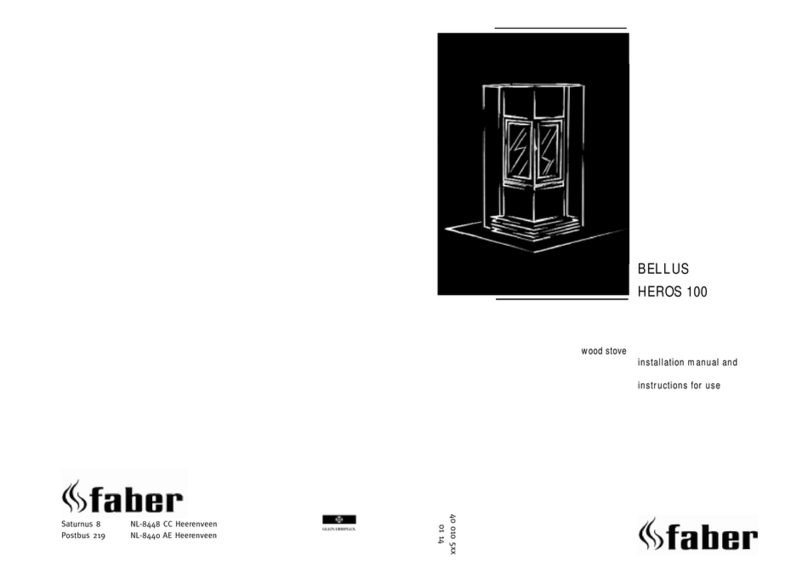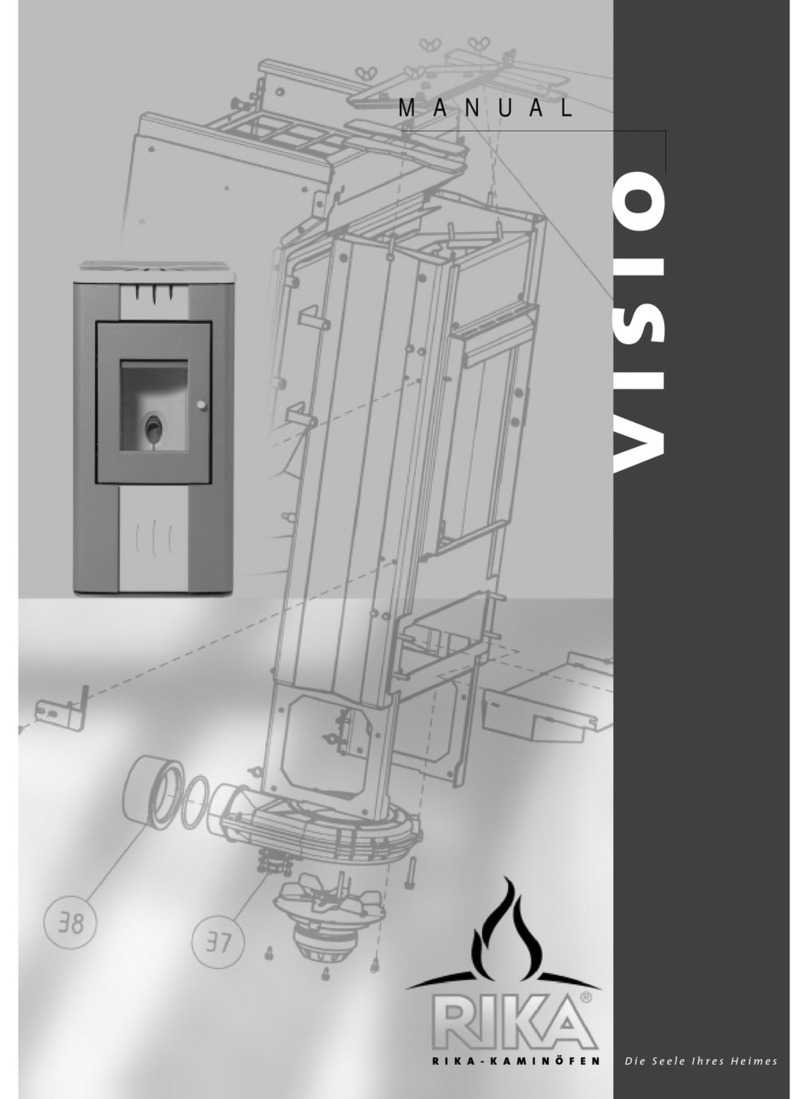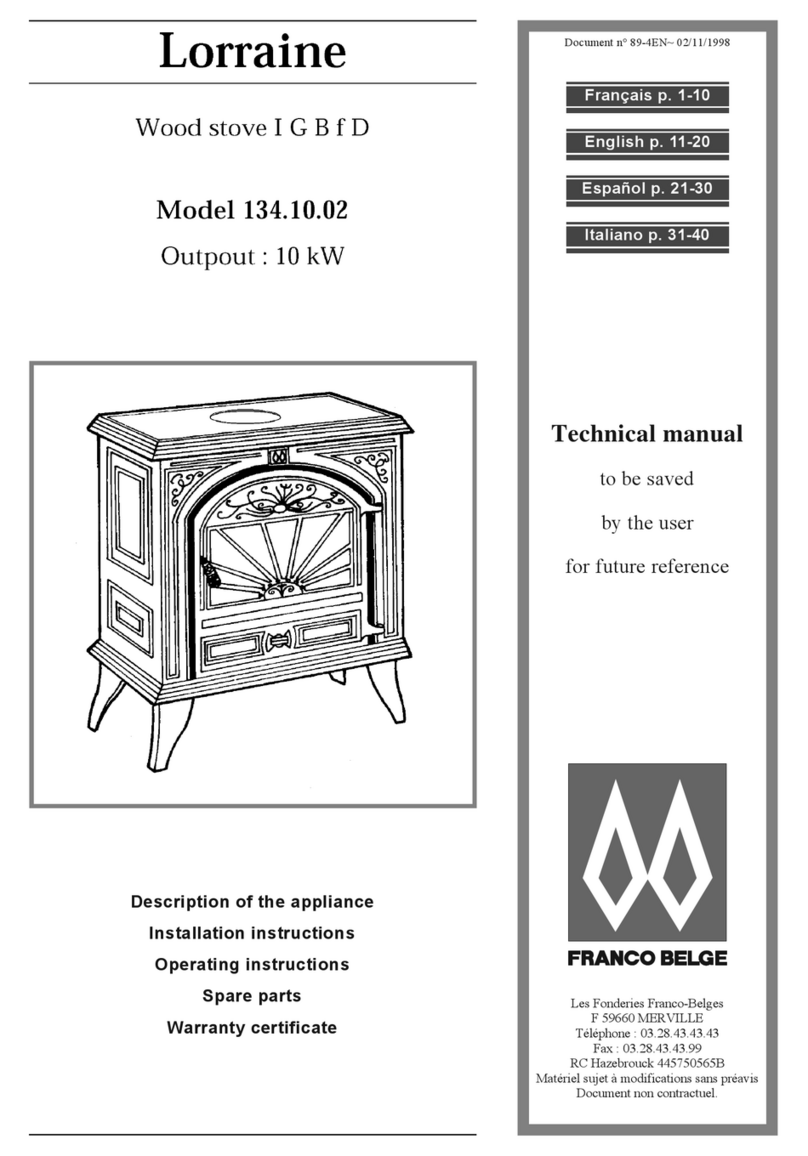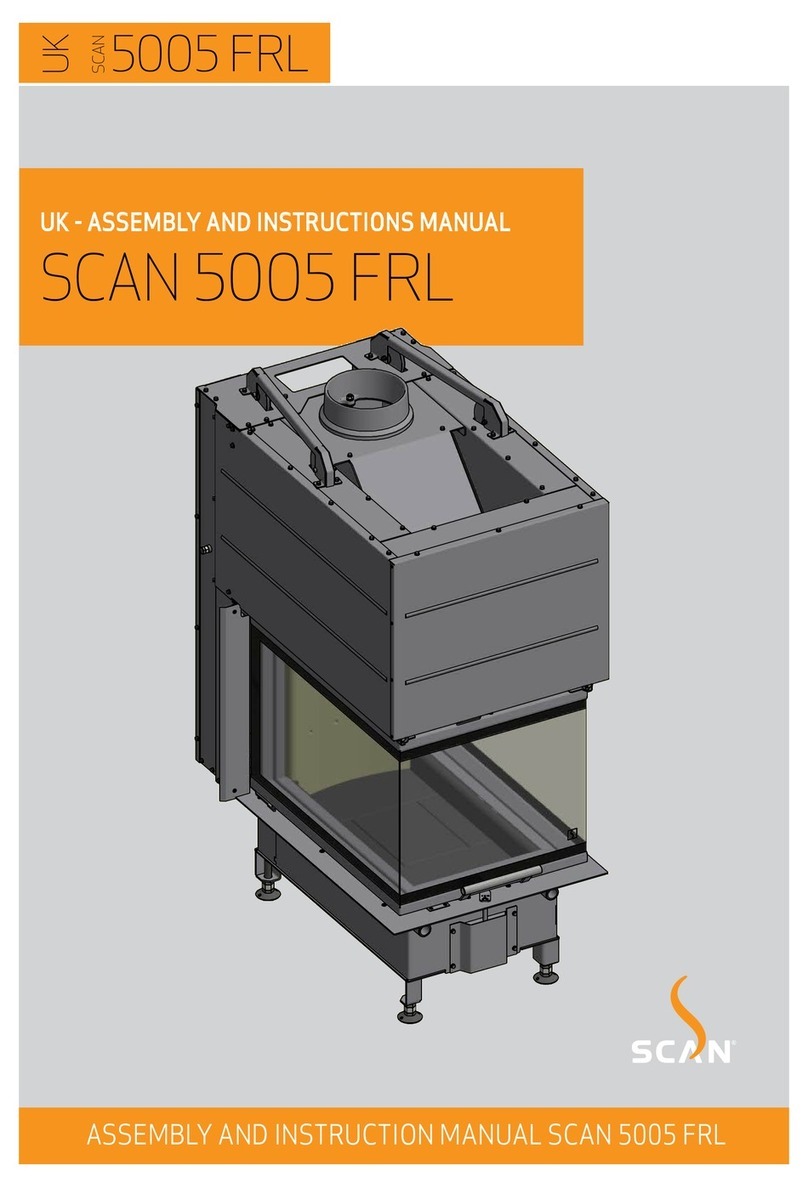MIDTHERM Pyrus V User manual

Operating
Instructions
Woodburning Stove
Please note:
Stove & chimney installations must be carried out by a two person team with one person
being a qualified & competant individual, e.g. HETAS installer or a competent individual and
inspected by a local building control officer.
A carbon monoxide detector must be fitted as part of the installation. Instruction on suitable
fuels/operation, cleaning and maintenance should be given by the installer to the home
owner based on their installation.
THIS DOCUMENTMUSTBE KEPTFOR THE FULLDURATION OFTHEWARRANTY/EXTENDED
WARRANTY PERIOD. It is also reccomended to be kept for general reference for the life of
the stove.
Midtherm Flue Systems Limited, New Road, Dudley, West Midlands, DY2 8SY
t+44(0)1384 458800 esales@midthermflue.co.uk wmidthermflue.co.uk
QF-34-55 INST (23D)
26/05/23
Pyrus V - 55500005
10
Year
Extended
Warranty

2
Stove Details
User Operating Instructions
Controls
Smoke Control Areas
Troubleshooting
Maintenance & Servicing
Installation Instructions
Warranty Information
.................................................................................................. 3
........................................................................ 4
.......................................................................................................... 6
.................................................................................... 8
............................................................................................ 9
............................................................................ 10
.............................................................................. 12
.................................................................................. 15
CONTENTS
Thank you for purchasing the Midtherm Pyrus V Woodburning Stove, which has been developed with
your comfort, efficiency and the environment in mind.
These instructions should help ensure your stove maintains the efficient burn that has seen it gain
approval for use even in smoke control areas. We hope you enjoy it, and welcome to the Midtherm
family.
Product Fiche EU 2015/1186
Midtherm Flue Systems Limited, New Road, Dudley, West Midlands, DY2 8SY
Model Pyrus V
Energy Efficiency Class A+
Direct Heat Output (KW) 5.0kW
Indirect Heat Output (KW) n/a
Energy Efficiency Index 112
Useful Energy Efficiency at Nominal Heat Output % 83.8%
Safety Precautions
The local space heater must be
assembled, installed and maintained
in accordance with manufacturer’s
Operating Instructions manual.

3
STOVE DETAILS
Dimensions
Data
Minimum Distance to
combustable Materials
All tests are carried out in accordance with BS EN 13240.
*The output is based on a 45 minute refuelling cycle burning seasoned hardwood logs.
** See installation instructions on page 14 for dimesions with spigot heat shield fitted.
Distance Single
wall flue
Twin wall & spigot
heat shield**
Rear Wall 250 140 mm
Side Wall 250 200 mm
Front (e.g. furniture & soft furnishings) 1100 1100 mm
Emission of CO in combustion products 0.10 %
Flue gas temperature 233 °C
Flue gas mass flow 3.7 g/sec
Rated heat output * 5.0 kW
Energy efficiency 83.8 %
Seasonal Efficiency 73.8 %
Average particulate emissions 12 mg/Nm3
OGC 74 mg/Nm3
NOx 84 mg/Nm3
Model Weight 93 Kg
Hearth Temperature >100 °C
Minimum Draught 12 Pa
565mm
375mm
545mm
126.5mm

4
USER OPERATING INSTRUCTIONS
Before use, check with the installer that these Stove Installation Instructions have been followed and
the flue and chimney have been correctly prepared / installed and commissioned. All local regulations
including those referring to National and European Standards need to be complied with when installing
the appliance.
As part of the stove’s commissioning and handover, the installer should have shown you how to operate
the stove correctly.
This stove is not suitable for use in a shared flue system. The stove is suitable for intermittent operation
and should not be used constantly for extended periods (e.g. not suitable for overnight burning). Read
through all sections of this manual before use.
This appliance is a wood burning appliance.
Only dry and well seasoned wood with a
moisture content of 20% or less may be burnt.
Well seasoned wood is wood that has been
stored for 12 months under cover with
ventilation on all sides.
Hard woods (Ash, Beech, Oak) are better
than soft woods (e.g. Pine, Chestnut, Cedar).
Hardwoods produce a higher heat output and
are less likely to crackle and spit.
LOGS: 2 off logs approximately 300mm long
(12 inches) x 75mm (3 inches) in diameter
KINDLING: 8-12 sticks approximately 150 to
200mm long (6-8 inches) x 15 to 50mm (< 2
inches) in diameter.
For a 45 minute burn achieving approximately
5kW output we recommend approximately
1.2kg of wood (approximately 2 of the above
size logs) to be placed onto a pre-established
fire bed.
Recommended Fuels
1. Burning wet or unseasoned wood, or by
using the stove irresponsibly may cause it to
emit smoke which is illegal in smoke control
areas and will not produce a satisfactory
heat output.
2. Burning wet or unseasoned wood may
reduce the life of the appliance and flue
liner, cause excessive smoke, lead to tar
deposits in the flue with an increased risk of
chimney fire; and the heat output will not
be achieved.
3. Do not burn bituminous coal, petro-coke,
other petroleum based fuels or treated
wood e.g. pallets as this will invalidate the
product warranty.
4. Do not burn household waste or use as an
incinerator.
5. Do not use liquid fuels / liquid firelighters.
6. Do not over-fire by using more fuel than
advised in these instructions and/or with
the air intake open for too long. Over-
firing could cause damage to the stove or
surrounding walls.
Please Note
These instructions contain guidelines for operating your stove. Your installer will show you how to
achieve the best performance for your installation.
LIGHTING & REFUELLING
• Do not leave the stove unattended while it is lighting.
• Do not operate with the door open except for as instructed below.
• Use the glove provided when touching the door handle and control of the stove after it has
been lit.
During the initial week of use, we recommend heating the stove gently, with a few kindling fires (GENTLE
FIRING). Gradually building up heat and longevity over the course of a week prevents issues such as
bubbling, peeling, or flaking of the paint. Throughout the first week, it is essential to avoid overheating
the stove too quickly or any subsequent overfiring
For proper curing of the door sealing rope, we advise allowing the stove to fully cool before opening the
door during the initial week of gentle firing.
Please Note

5
Lighting
1. Move the air control into the Boost setting.
2. Place 2 to 3 larger pieces of split wood /
kindling on the bottom of the fire box.
3. Put 8-12 kindling sticks (softwood) on top,
ensuring that air can flow around them, e.g.
layer them in a stack or build a pyramid.
4. Check that the height of the wood
doesn’t exceed the height of the tertiary
air inlet holes at the back of the stove (at
approximately half way up the stove), and
that the fuel doesn’t spill over the front
grille.
5. Put 2-3 Eco friendly firelighters and / or
paper on top of the fuel stack in the centre.
6. Use a long match to light the firelighter /
paper.
7. Close the door. If the kindling doesn’t
catch fire open the door slightly for up to
3 minutes until flames appear – then close
the door again.
8. When the kindling is well lit, open the door
slightly and wait a few moments before
opening fully (to avoid smoke escaping into
the room).
9. Place the correct quantity of well seasoned
dry wood in the stove (either parallel or
perpendicular to the glass).
10. Close the door. If the logs don’t catch fire,
open the door slightly for up to 3 minutes
until flames appear on both logs, then close
again.
11. Once the fire has caught well and the
temperature is increasing the air control
can be turned down. At about half way
the primary air will close off leaving the
secondary air and tertiary air to circulate
over the fuel.
12. Ash should be left on the base when
relighting. If the fire bed is full of ash e.g.
it has built up behind the front grille, or is
covering the primary air inlet holes, some
should be removed.
Refuelling
When excessive ash has built up on the base of the fire box (front grille or primary air inlet holes at back
of stove are covered), this should be removed.
• Allow the ash to cool sufficiently that it can be removed safely.
• Ash should be scooped up and put into a steel ash carrier.
Ash Clearance
To reduce smoke and emissions it is important
to refuel onto a bed of hot embers. If there
are no remaining hot embers then use some
kindling to relight the fire with the air control
fully open and the door slightly open if
necessary. To refuel onto an existing bed of
hot embers:
1. Open the door slightly. Leave for a few
moments before opening fully.
2. Separate the burnt wood and spread evenly
over the fire bed with a suitable tool.
3. Place the correct quantity of well seasoned
dry wood in the stove (either parallel or
perpendicular to the glass). Allow some
space between the logs to allow the air to
circulate around them. Make sure that logs
do not protrude beyond the front grille as
this could cause damage to the glass and
will cause the glass to blacken.
4. Check that the height of the logs doesn’t
exceed the height of the tertiary air
inlet holes at the back of the stove (at
approximately half way up the stove), and
that the fuel doesn’t spill over the front
grille. Overloading can cause excessive
smoke.
5. Move the air control into the fully open
boost setting.
6. Close the door. If the logs don’t catch fire
open the door slightly for up to 3 minutes
until flames appear – then close the door
again.
7. Once the fire has caught well and the
temperature is increasing the air control
can be turned down. At about half way
the primary air will close off leaving the
secondary air and tertiary air to circulate
over the fuel.
NOTE: Ensure boost setting is used as detailed
abovewhen refuellling. Failing to do sowill result
in the stove slumbering. This is detrimental
to stove performance and can cause smoke
and chemical condensate, leading to tar and
deposit build-up.
Initial Lighting
On initial lighting please ensure that the room is well ventilated with doors/windows open as necessary,
as it is normal for the stove itself to give off smoke and odour from the stove paint for a short period of
time. Allow the stove to burn for 2 to 3 hours slowly initially to evaporate residual moisture that may be
present in the chimney.

6
Below are details of the air inlet positions. These are all controlled by the single lever on the front of
the stove.
CONTROLS
Air Inlet Location
Primary Bottom air inlet holes in the vermiculite board at the back of the stove. Acts as a
“Boost” function when lighting and refuelling.
Secondary Air wash that comes down the front of the glass and helps to keep the glass clean.
Tertiary
Upper air inlet holes in the vermiculite board at the back of the stove. Second-
ary and tertiary air mix together and flow over the top of the wood and circulate
around the firebox.
BOOST SETTING
Fully open, control all the way to the right.
For initial start-up only.
NOMINAL SETTING
Primary Inlet off.
Exact nominal setting will vary
depending upon installation, fuel,
and environmental factors.
MINIMUM SETTING
Primary air intake closed.
Minimum supply to secondary &
tertiary inlets provided.
Smoke Control Setting
Becomes the minimum setting in
smoke control areas.
Slide and screw into place as a
physical stop for the control arm.
View (right) is looking at underside
front edge of stove.
Smoke Control
Stop in position

7
Building regulations require that whenever a
new or replacement fixed solid fuel or wood /
biomass appliance is installed in a dwelling a
carbon monoxide alarm must be fitted, in the
same room as the appliance. Further guidance
is available in the latest issue of BS EN 50292
and the alarm instructions. The installation of
such an alarm is not considered a substitute
for regular maintenance or servicing of the
appliance and flue system.
• Raise the alarm
• Call the Fire Brigade
• Close appliance air controls
• Move furniture, ornaments etc. away
• Place a fireguard in front of stove
• Check the chimney breast for signs of
excessive heat.
• If the wall is becoming excessively hot,
move furniture away.
Ensure the Fire Brigade can gain access to your
roof space in order to check for fire spread.
Always use a fireguard in the presence of
children, the elderly or the infirm. The fireguard
should be manufactured in accordance with
BS8423 – Fireguards for use with solid fuel
appliances.
Fitting a stove in a room which also contains
an extractor fan and/or cooker hood should be
avoided where possible. If this is unavoidable,
the suitability of the space for fitting this
appliance must be decided at the discretion
of a qualified installer, and a flue draught
interference test must be performed.
It is essential that the stove has an adequate
air supply for combustion and ventilation.
Requirements can be found by checking
Building Regulations Approved Document J.
Do not obstruct the ventilation required for the
safe use of this appliance.
This appliance will be hot when in operation
and due care should be taken.
We advise that the gloves provided are used
when operating the air control, and when
opening the door.
Do not use an aerosol spray on or near the stove
when it is alight. There is a risk of explosion or
flash ignition for the spray.
Properly installed and operated, this appliance
will not emit fumes. Occasional fumes from
de-ashing and refuelling may occur. Persistent
fume emission must not be tolerated.
This appliance should not be operated with the
door open.
If fume emission persists, then the following
immediate action should be taken:
• Open doors and windows to ventilate the
room.
• Let the fire go out or eject and safely
dispose of fuel from the appliance.
• Check for flue/chimney blockage and clean
if required.
• Do not attempt to re-light the fire until
the cause of the fume emission has been
identified and corrected.
If necessary, seek expert advice.
IMPORTANT NOTES
Carbon Monoxide Detector
In The Event Of A Chimney Fire
Fire Guards
Extractor Fan
Ventilation
Warning
Aerosols
Warning Note

8
SMOKE CONTROL AREAS
Under the Clean Air Act local authorities may declare the whole or part of the district of the authority to
be a smoke control area. It is an offence to emit smoke from a chimney of a building, furnace or any fixed
boiler if located in a designated smoke control area. It is also an offence to acquire an “unauthorised
fuel” for use within a smoke control area (unless it is used in an “exempt” appliance from the controls
which generally apply in the smoke control area).
In England appliances are exempted by publication on a list by the Secretary of State in accordance
with changes made to sections 20 and 21 of the Clean Air Act 1993 by section 15 of the Deregulation Act
2015. In Scotland appliances are exempted by publication on a list by Scottish Ministers under section
50 of the Regulatory Reform (Scotland) Act 2014. In Wales and Northern Ireland these are authorised
by regulations made by Welsh Ministers and by the Department of the Environment respectively.
Your local authority is responsible for implementing the Clean Air Act 1993 including designation and
supervision of smoke control areas. Further information can be found here: www.gov.uk/smoke-
control-area-rules.
The Midtherm Pyrus V has been recommended as suitable for use in smoke control areas when burning
wood logs with a moisture content of 20% orless. The Midtherm Pyrus Vmust be fitted with a permanent
stop preventing the closure of the secondary and tertiary air intake.
The Clean Air Act 1993 and Smoke Control Areas
If there is insufficient burning material in the
firebed to light a new fuel charge, excessive
smoke emission can occur. Refuelling must be
carried out onto a sufficient quantity of glowing
embers and ash such that the new fuel charge
will ignite in a reasonable period. If there are
too few embers in the fire bed, add suitable
kindling to prevent excessive smoke.
Refuelling Onto A Low Firebed
To ensure a more environmentally friendly way
of burning your stove, avoid turning it down
to the point where you cannot see any visible
flames. If the stove is run this way then the gases
produced from the wood will not be burnt off
(due to low temperatures in the chamber).
This can also cause soot to condense in the
flue system and could lead to a chimney fire.
The smoke that is left as it exits the chimney
will also pollute the surroundings and cause an
unpleasant smell.
Remember that your chimney (however good)
will not perform well if the stove is not used
correctly.
The Environment
The maximum amount of fuel specified in this
manual should not be exceeded, overloading
can cause excess smoke.
Fuel Overloading
Operation with all air controls fully open can
cause excess smoke. The appliance must not
be operated with air controls or door left open
except as directed in the instructions.
Controls Left Open
Operation with the door open can cause excess
smoke and fume spillage into the room. The
appliance is tested as a closed door appliance
and must not be operated with the appliance
door left open except as directed in the
instructions, e.g. when lighting and refuelling
as directed in these instructions.
Operation With Door Open

9
TROUBLESHOOTING
This can happen for a variety of reasons e.g
cold air trapped in chimney/flue. As cold air is
denser, this causes smoke to be forced back
down the chimney. We recommend trying to
heat the chimney before lighting for example,
placing a firelighter on top of the kindling.
Ensure wood has a moisture content of less
than 20% as this can cause excess smoke. Also
check the type of wood as softwood produces
more smoke than hardwood.
Smoke
There are varying reasons for problems with stove
operation, including:
• A low or high flue draught in which case you
need to speak to your installer. Correct use of
the air controls (please refer to instructions).
• Quality and moisture content of fuel.
• Check that chimney is not blocked or that
nearby buildings or trees affect the wind
around it.
Operation Of Fire
• Check the flue draught of the stove is not too strong or too low.
• Is the air vent blocked?
• Is an extractor fan running or are their more doors / windows open than usual?
• Check use of air controls (please refer to these instructions).
• Ensure that the amount of kindling used is enough to light the added fuel.
• Try heating the flue/chimney up first following the lighting procedure to ensure that the flue is warm
which will improve the draught.
Fire Goes Out After A Short Time
If your glass is blackening this can be due to
incorrect use of air controls (see instructions).
Alternatively, poor quality fuel which has a high
moisture content can also be a cause. When
the glass has a white shadow (or crazing) on
the inside then this can be caused due to over-
firing, too much primary air or a vacuum in the
room.
Glass
Varying weather can have an impact on the
way the stove burns, especially the wind. An
anti-down draught cowl might need to be
fitted (speak to a specialist) or a flue damper
may also be of help. Mist and fog may also have
an impact on the chimney draught and you will
need to change the settings you are using on
the stove.
Weather Conditions
The stove paint curing process requires ‘gentle
firing’ to take place to ensure surface coating
is virtually free from fumes and odours. We
recommend when carrying out this operation
for the first time that windows and doors are
opened for a short time to provide ventilation.
If the surface of the appliance turns grey or the
paint starts to flake or peel then this is caused
by over-firing.
In case the paint experiences bubbling,
peeling, or flaking, it’s necessary to sand down
the affected area and apply a new coat of
Midtherm stove paint.
Paint Curing
When the appliance body heats up and cools
down it may make some clicking noises. This is
due to the large temperature differences and is
not a problem with the appliance.
Noise
If the door sealing rope becomes loose, it may
be the result of not ‘gentle firing’ the stove,
or overfiring thereafter. Reattach using stove
rope glue, following the process of gentle firing
as outlined in the INITIAL LIGHTING section.
Door Sealing Rope

10
MAINTENANCE & SERVICING
If the stove is to be left unused for a prolonged period, then it should be given a thorough clean to
remove ash and unburned fuel residues. To enable a good flow of air through the appliance to reduce
condensation and subsequent damage, leave the air controls fully open.
If the appliance has been unused for a long period, such as during the spring and summer months, a
competent person should check the chimney for potential obstructions before lighting the stove i.e.
get the chimney swept before the start of the heating season.
Periods Of Prolonged Non-Use
The glass sealing tape will have to be replaced
when a new piece of glass is fitted as the self-
adhesive tape is stuck onto the glass. Over time
you may also find that the gasket tape changes
colour which is expected.
Glass Sealing Tape
Process for removal and replacement of the
glass panel:
• If glass needs replacing a new piece of glass
sealing tape will also be required.
• Unscrew the screws that hold in the glass
clips carefully and then remove the glass.
• Fit the new piece of glass sealing tape in
position.
• Fit the glass in place.
• The clips and screws should only be
finger tight to allow for the expansion and
contraction of the glass.
Clean the glass panel when cool with a damp
soft cloth. If residue is more difficult to clear
use a gentle glass cleaner. Apply the cleaner
to a non-abrasive cloth (not directly onto the
glass as it could run and soak into the sealing
tape.
Wet logs on heated glass, a badly aimed poker
or heavy slamming of the doors could crack
the glass panels, the glass will not fracture from
heat. Please check periodically that the glass
clips and screws have not become loose.
Glass Panel
In normal use, the firebricks can last for many
years. It is possible however, to crack them if
logs are continually jammed against them or if
they are frequently struck with a poker. Check
periodically for seriously cracked bricks, which
can be replaced with new fire bricks, available
from Midtherm.
Process for removal and replacement of the
firebricks and log guard:
1. Lift the front log guard above the bottom
firebricks and turn one side inwards to be
able to remove from the stove.
2. Remove the bottom fire bricks.
3. Loosen the two screws in the top baffle
plate.
4. While supporting the top baffle brick, pull
the top of the left side brick in towards the
centre of the firebox and remove.
5. Drop top baffle brick down on left side and
remove from the firebox.
6. Pull the top of the right side brick in towards
the centre of the fire box and remove.
7. Pull the top of the rear bricks towards you
and remove from the firebox.
Follow this process in reverse to replace the fire
bricks. When re-fitting the log guard, ensure
that it is correctly seated and held in place by
the firebricks
Firebricks & Log Guard
Check the door seal rope periodically. If rope is
becoming detached, use rope glue to reattach.
If the rope is worn or frayed, a replacement
rope is available from Midtherm.
Door Sealing Rope
You can wipe the stove with a damp, lint free
cloth. Repair any light damage with stove paint
available from Midtherm.
Stove Body

11
Midtherm recommend that this appliance be
serviced at least annually, preferably prior to
the start of the heating season, and in time to
order any replacement parts should they be
needed. This should be carried out by your
competent chimney sweep.
Remove all the internal components: Log
retainer, fire bricks, top baffle brick. Clean them
with a soft brush carefully and inspect them for
damage.
Sweep the chimney/flue system.
Clean down the internal surfaces of the
appliance using a scraper or wire brush.
Inspect these surfaces for damage/corrosion.
If corrosion or damage is found, we advise that
you consult with your chimney sweep about
rectification/repair.
Brush out or vacuum the inside of the appliance
and re-fit the internal components.
Inspect the glass door sealing rope. Clean the
glass with a non-abrasive cleaner if required. If
the door sealing rope is torn or damaged, we
recommend that is replaced to ensure that no
products of combustion enter the room when
the appliance is used.
Painted finish – Wipe the stove with a damp
lint free cloth. Repair any light damage with
Midtherm stove paint spray.
Annual Service
The bafflebrick is locatedin theupperpartofthe
stove and this should be removed and cleaned
on a regular basis. This prevents any build-up
of soot or fly ash that could lead to blocked
flue ways and dangerous fume emission. See
below for instructions for removal.
All spare parts can be purchased from Midtherm. See purchasable parts list below for more details.
Please Note: Only use manufacturer recommended spare parts
Spare Parts
Description Product Code Included in
Warranty?
Midtherm Stove Gloves 55510001 No
Midtherm Stove Shovel 555100011 No
Pyrus V Glass Kit 55550005 No
Pyrus V Vermiculite Kit 55550005A No
Pyrus V Door Seal Kit 55550005B No
Pyrus V Handle & Hinge 55550005C No
Pyrus V Spigot Replacement 55550005D No
Stove paint No
WARNING! Modifications to the stove are not permitted and will void your warranty
Baffle Brick
If the baffle brick is removed the chimney/
flue can be swept through the appliance. For
rear outlet stoves access may be via a tee cap.
Additional access may be available via cleaning
doors in the flue – especially if the route requires
this to ensure the full length of the flue can be
easily swept.
It is important that the chimney, flue ways and
any connecting flue pipe are swept twice a
year for woodburning appliances.
Cleaning the chimney and flue should only be
carried out by an experienced chimney sweep
with a trusted trade rating.
If the stove is fitted in place of an open fire,
then the chimney should be swept one month
after installation to clear any soot falls which
may have occurred due to the difference in
combustion between the stove and the open
fire.
Chimney & Flue

12
INSTALLATION INSTRUCTIONS
Competent Persons Scheme
Legal Requirements
Midtherm recommend that this stove be installed by a member of an accredited competent persons
scheme e.g. HETAS. This is also a requirement for the extended warranty scheme to be valid.
If the installer is not a member of a competent persons scheme, it is a legal requirement, in the UK, to
notify your Local Building Control Officer in advance of any installation work starting.
These instructions cover the basic principles to ensure satisfactory installation of the stove, although
details may need slight modification to suit particular local site conditions.
All local regulations, including those referring to National and European Standards need to be complied
with when installing the appliance. In all cases the installation must comply with British Standard
BS8303 Code of Practice for installation of domestic heating and cooking appliances burning solid fuel,
current Building Regulations, Local Authority Byelaws, European and National Standards and other
specifications or regulations.
Ensure any existing chimneys are clear of obstruction and have been swept prior to installation. If the
stove is being fitted into a previous open fireplace then the chimney must be swept one month after
fitting.
• An existing fireplace opening can be bricked up or sealed with a register plate with consideration for
access for cleaning (e.g. a register plate with access door).
• A short length of flue pipe with a minimum internal diameter 125mm may be used to connect the stove
to the chimney.
• This flue pipe should be made of 316 grade stainless steel or vitreous enamelled steel, e.g. either
Midtherm SW 316 0.9mm or Midtherm Vitrelux.
• The length of any horizontal run of flue pipe must not exceed 150mm.
• Alternatively a Midtherm HT-S twin wall starter length with a 0.9mm inner or HT-S 0.9mm liner
components can be used off the top of the appliance.
• For rear connections Midtherm HT-S 0.9mm thick liner components can be used off the back of the
appliance.
• The horizontal distance can be increased to 450mm provided that a flue calculation to BS EN 13384
has been carried out to check the draught.
• It is essential that all connections between the stove and chimney/flue are sealed and made airtight.
Any bend in the chimney or connected flue pipe should not exceed 45°. 90° bends should not be used.
• Make provision to access the chimney/flue system for cleaning and the removal of debris.
• Single wall connecting flue pipes should have a maximum length of 1.5m and be located internally only.
If found necessary to line the chimney then a twin wall flexible flue liner for solid fuel must be used.
If there is no existing chimney then either a prefabricated block chimney or a twin-walled insulated
stainless-steel chimney to meet the requirements of the installation standard BS EN 15287-1 can
be used. These chimneys must be fitted in accordance with the requirements of BS EN 15287-1,
manufacturer’s instructions and Building Regulations. New masonry and flue block chimneys must meet
the requirements of Building Regulations Document J. Any connecting flue pipe systems must also
meet these regulations.
Please check the suitability of the fireplace and/or surround for use with this appliance before installing
it. If you have any doubts about the suitability of your chimney, consult your local Installation Engineer.
Connection to the Chimney

13
Hearth constructions must comply with the current building regulations. The stove must be installed
on a floor with adequate load-bearing capacity; otherwise suitable measures should be taken. If the
existing construction does not meet requirements, suitable measures (e.g. load distributing plate)
should be put in place. The hearth should extend at least 400mm from the front of the appliance and
at least 150mm to the sides. The stove door when open will extend beyond the hearth.
If the standard leg option is installed the stove should stand wholly above a solid constructional hearth,
at least 125 mm thick. A constructional hearth should be made of solid, non-combustible material,
such as concrete or masonry, at least 125mm thick, including the thickness of any non-combustible
floor and/or decorative surface. Please refer to Building Regulations Approved Document J for further
information.
Professional advice should be sought from your supplier or local building inspector if there is any doubt
about the hearth positioning.
The fireplace should allow good air circulation and should be dimensioned to avoid overheating. A gap
of 150mm each side and 300mm above the fire should be sufficient. If a wooden beam is present then
a minimum distance of 460mm (preferably 600mm) should be maintained. A protective shield may be
required for the mantelpiece or beam in some situations.
The distance behind the appliance to allow access must be a minimum of 50mm but may need to be
increased to meet Building Regulations.
Hearth & Fire Surround
Some types of fire cement are caustic and
should not be allowed to come into contactwith
the skin. In case of contact, wash immediately
with plenty of water.
When installing or servicing this stove, care
should be taken to avoid the possibility of
personal injury.
Metal Parts
This stove must not be installed into a chimney
that serves any other heating appliance.
Important Warning
This appliance is very heavy. Adequate facilities
must be available for loading, unloading and
site handling.
Handling
This stove contains no asbestos. If there is
any possibility of disturbing any asbestos in
the course of installation, then please seek
specialist guidance and use appropriate
protective equipment.
This is a domestic appliance and must only be
used in accordance with these instructions.
Stove Performance
Health and Safety Guidance
Special care must be taken when installing the stove such that the requirements of the Health and
Safety at Work Act are met.
Fire CementAsbestos
The room or space containing this appliance does not need a permanent, unobstructed air opening
unless the air permeability rating is less than or equal to 5m³/(h.m²). Refer to Building Regulation Doc J.
If a draught stabiliser is fitted, refer to Building Regulation Doc J .
Due consideration should be given to air requirements for any other appliance in the same room or
space.
Any air opening must be kept clear from blockage or obstruction.
Air Supply

14
Distance to Combustible Materials
Airtight HousesCertificate of Compliance
Unpacking
Flue Collar & Blanking Plate
Direct Air Kit
Data Plate
Attention is needed in airtight houses where
the design air permeability is less than 5m3/
(h.m2). Approved Document J and Appendix F
gives further information. A window opening is
not appropriate.
After completion of the appliance installation
please ensure the Certificate of Compliance
is completed by the installer to comply with
the requirements of HETAS and Building
Regulations. The installer must supply these
details, including registration number to the
homeowner for their insurance purposes.
Remove all packing. Remove internal
components to make handling the stove
easier and protect them from damage during
installation.
• Instructions
• Pair of gloves
• Fire bricks
• Shovel
• Flue collar fixing box
• Spigot heat shield
The flue collar and blanking plate can be
removed and replaced in the opposite
orientation to blank off the unused connection
point.
If a direct air kit is required, this is available
from Midtherm.
The data plate is attached to the back of the
stove. It must remain accessible when the
stove is in it’s final location.
When the stove is to be installed within the
vicinity of combustible walls the following
minimum ventilated distances (here in mm)
must be maintained.
A
C
B
Distance SW Flue TW Flue & Spigot
Heat Shield
A 250mm 140mm
B 250mm 200mm
C 1100mm 1100mm
23
23
BS EN 13240: 2001+A2:2004
Product Type
Intended Use
Fuel Type
Minimum clearance to combustible materials (mm)
Follow the user’s instructions.
This stove must not be used in a shared flue.
Use only recommended fuels.
This stove is suitable for intermittent operation.
Midtherm Flue Systems Limited, New Road, Netherton,
Dudley, West Midlands, DY2 8SY
Room heater fired by solid fuel
Residential room heater
Wood
Flue
Rear wall
Side wall
Front (e.g. furniture)
Emission of CO in combustion products
Flue gas temperature
Flue gas mass flow
Thermal output
Energy efficiency
Average particulate emissions
OGC
NOx
Single wall
250
250
1100
0.10
233
3.7
5.0
83.8
12
74
84
%
oC
g/sec
kW
%
mg/m3
mg/m3
mg/m3
Twin wall + heat shield
140
200
1100
Spigot Heat Shield (Below)
Spigot heat shield supplied inside stove to be
fitted if required for installation type.

15
• Scan the QR code on the right with your phone camera,
or visit:
https://midthermflue.co.uk.....
• Fill out the online form carefully and submit it to us
• Keep a note of your unique Warranty ID from the
Registration Receipt email
• Note: any incorrectly submitted information may void
the warranty
Warranty Registration
The metal firebox of your Midtherm Pyrus V
comes with a 1 year warranty from date of
purchase. We also offer a 5 year extended
warranty scheme for registered appliances
when purchased from an authorised Midtherm
Stoves stockist (this increases to 10 years
when installed with Midtherm flue and
chimney components from the appliance to
termination). See warranty scheme terms &
conditions for full details.
Warranty Scheme
For the extended 5/10 year warranty to be
valid, please register your Midtherm Pyrus
V stove onto the warranty scheme by
completing the online form as instructed
below. The unique warrranty ID should
be kept safe and referenced in any future
correspondence.
You should register your stove within 28
days of comissioning (this should be within 2
months of purchase).
Extended Scheme
Commissioning
Check that the fire bricks and baffle brick are all fitted correctly.
Check that the door closes properly.
Once the installation is complete allow sufficient time for any fire
cement or building work to dry out properly before lighting the stove.
Commission the appliance in line with BS EN 15287-1 and Building
Regulation requirements. Check that fumes and smoke are emitted
safely from the top of the chimney.
On satisfactory completion of the commissioning process leave
these instructions with the customer and run through the following
details with them adding any useful information dependant upon their
particular location / installation:
• Safety
• CO alarm
• Recommended fuels
• Lighting
• Refuelling
• What to do in the event of a chimney fire
• Trouble shooting
• Maintenance
• Chimney sweeping
• Annual servicing
COMING SOON!
To dispose of the stove after the product life has expired, please observe the following information:
• Dispose of the items correctly i.e separate the parts to be disposed of in material groups.
• Always dispose of items in a way that is as sustainable as possible and that is in line with the current
environmental protection, reprocessing/recycling disposal technology.
Recycling

Midtherm Flue Systems Limited, New Road, Dudley, West Midlands, DY2 8SY
t+44(0)1384 458800 esales@midthermflue.co.uk wmidthermflue.co.uk
manufacturing in dudley since 1968
Provide exceptional UK designed and manufactured
products. To exceed all customers’ expectations by
applying our extensive knowledge and experience
while living our family values of integrity, honesty,
support, loyalty and longevity all incorportated within
the midtherm way
.
Batch Number Batch Completion Date Warranty ID
(To be filled in by user)
OUR MISSION...
Table of contents
Popular Wood Stove manuals by other brands
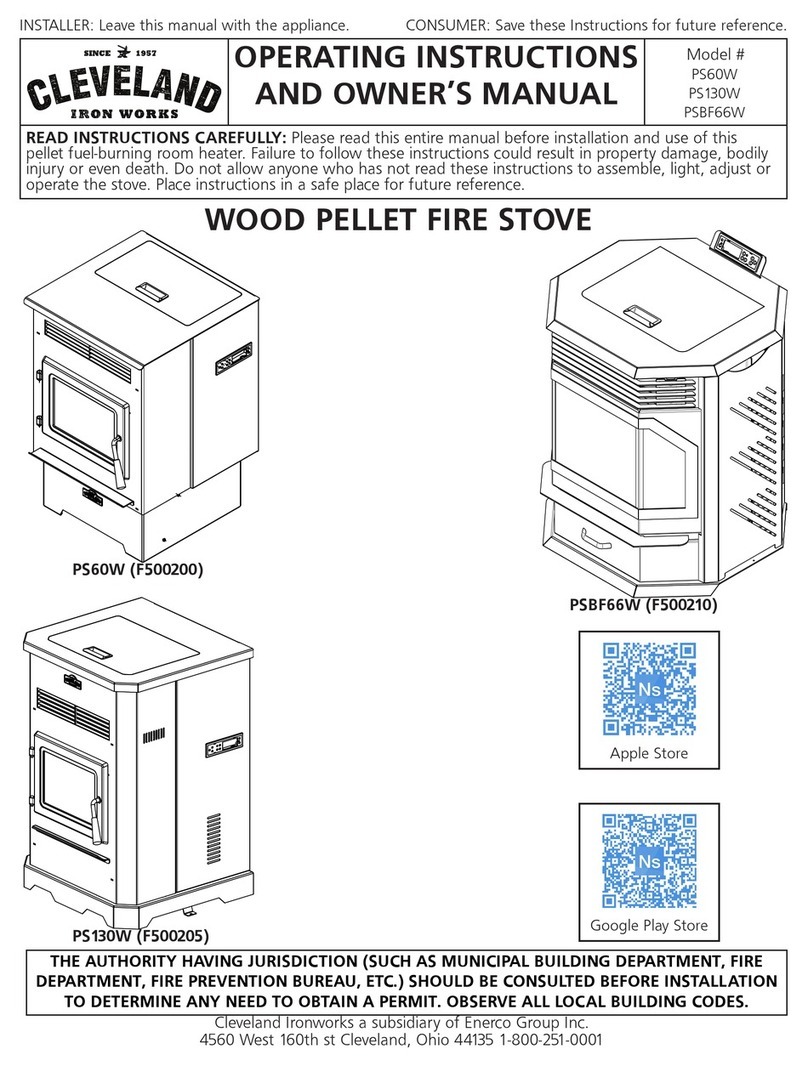
Cleveland
Cleveland PS60W Operating instructions and owner's manual

Nibe
Nibe Contura C210 manual
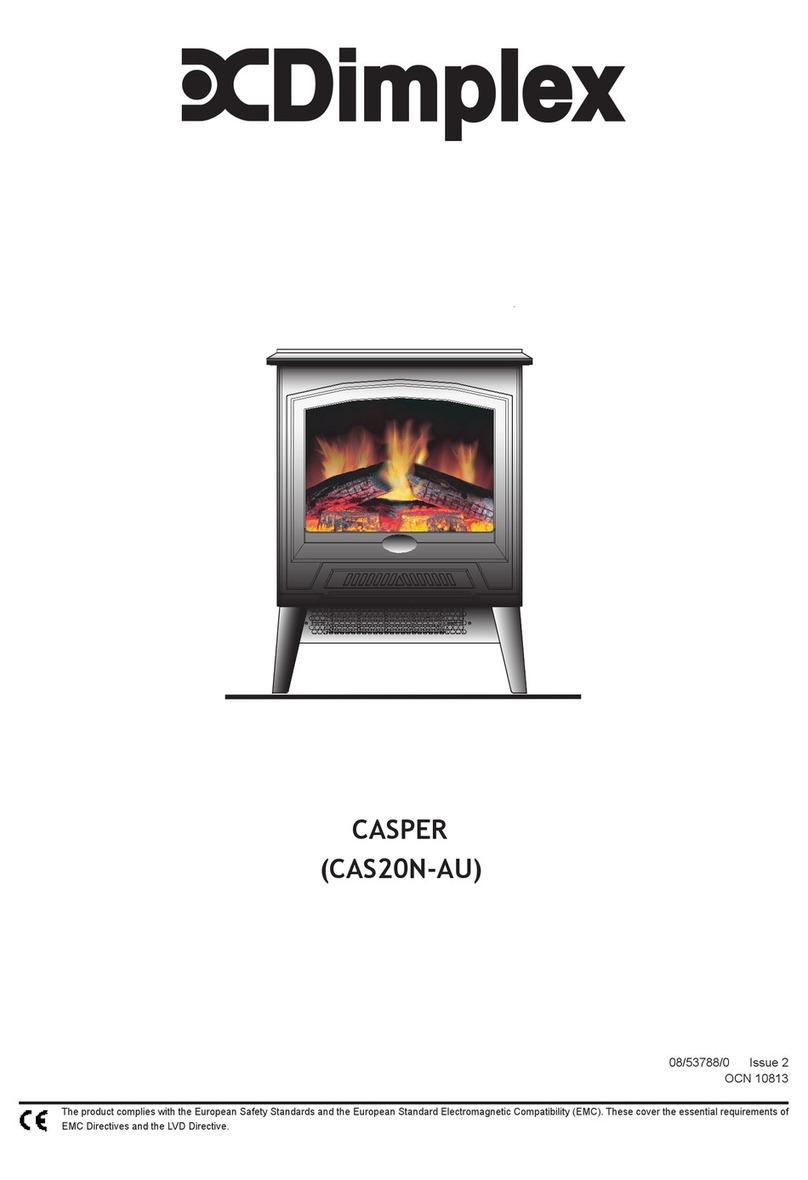
Dimplex
Dimplex CAS20N-AU manual

Quadra-Fire
Quadra-Fire Explorer II series installation manual
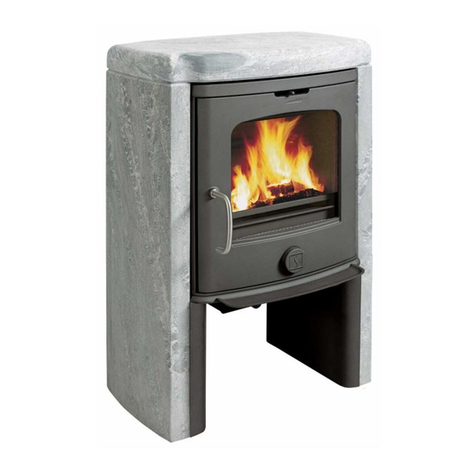
SCAN
SCAN Andersen 4-5 Installation and operating instructions
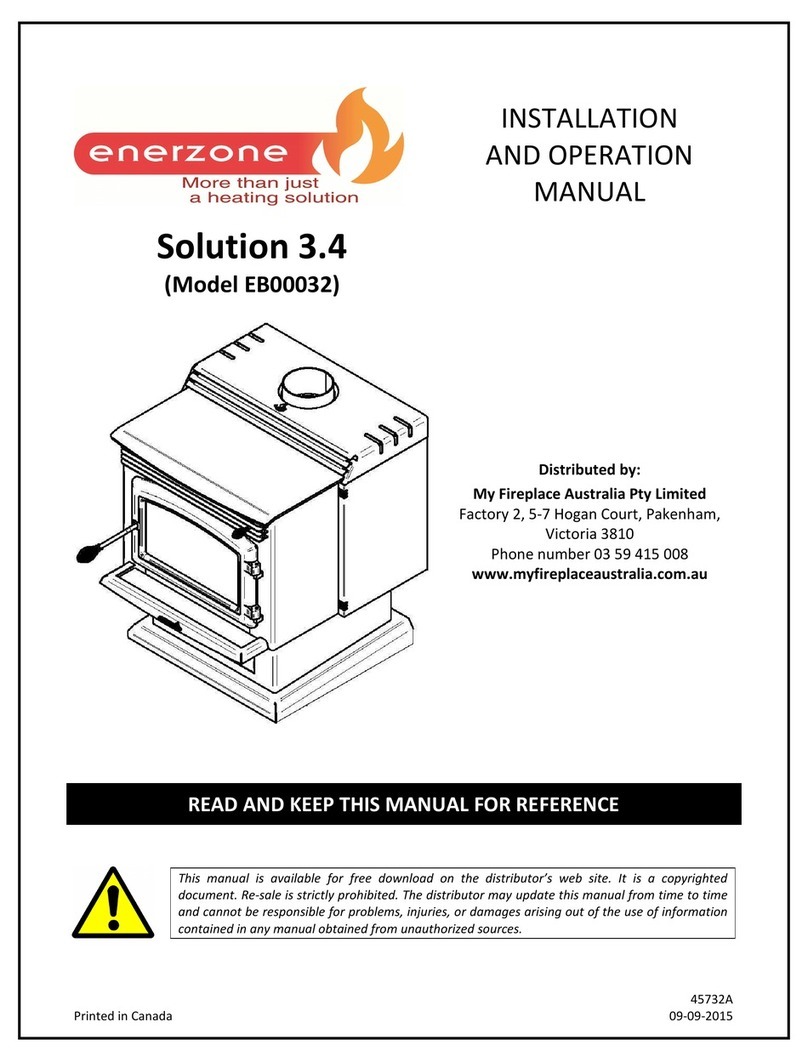
Enerzone
Enerzone EB00032 Installation and operation manual

Regency
Regency F2400M Owners & installation manual
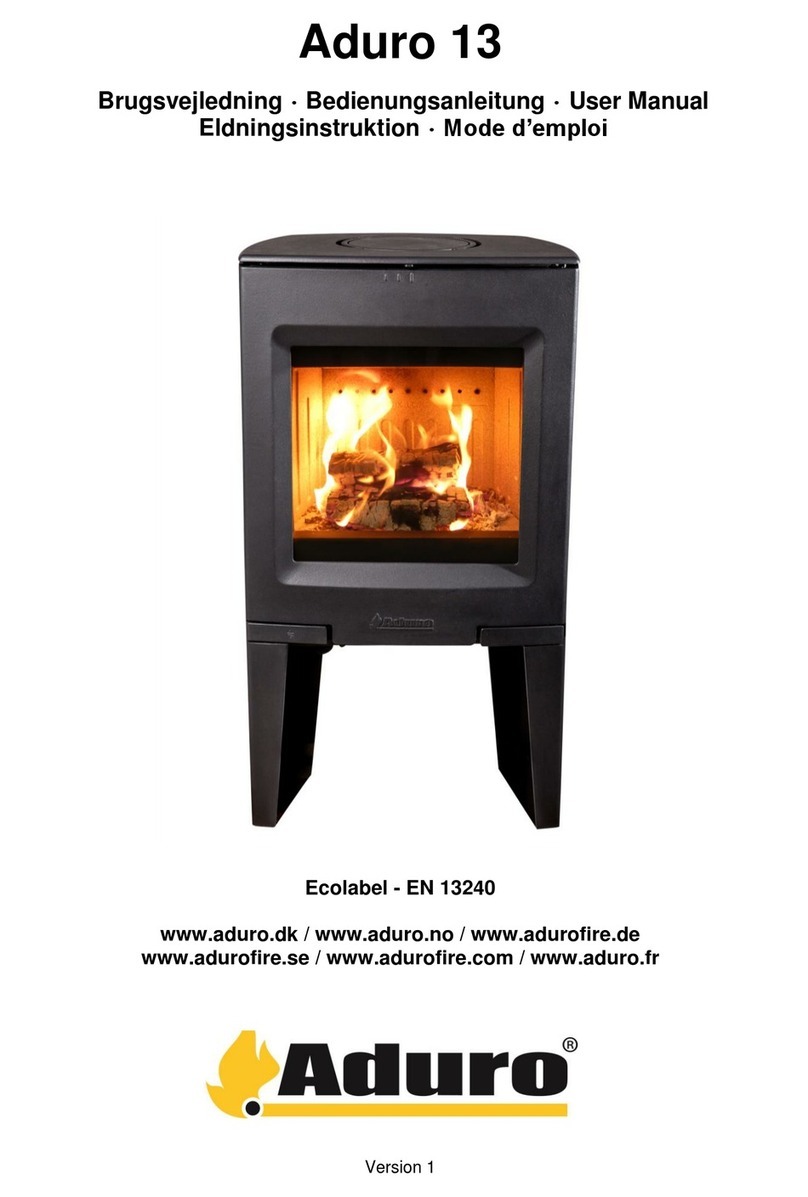
ADURO
ADURO 13 user manual

Timberwolf
Timberwolf Economizer 2100 Installation and operating instructions
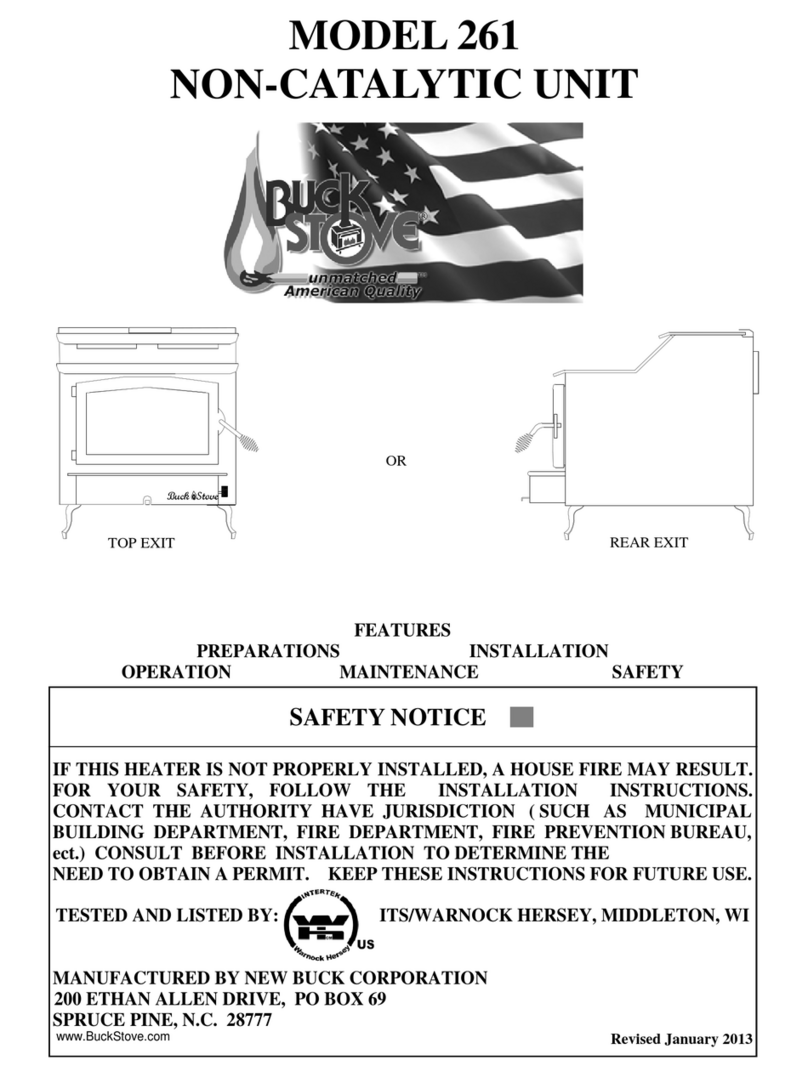
Buck
Buck 261 Installation, operation and maintenance instructions
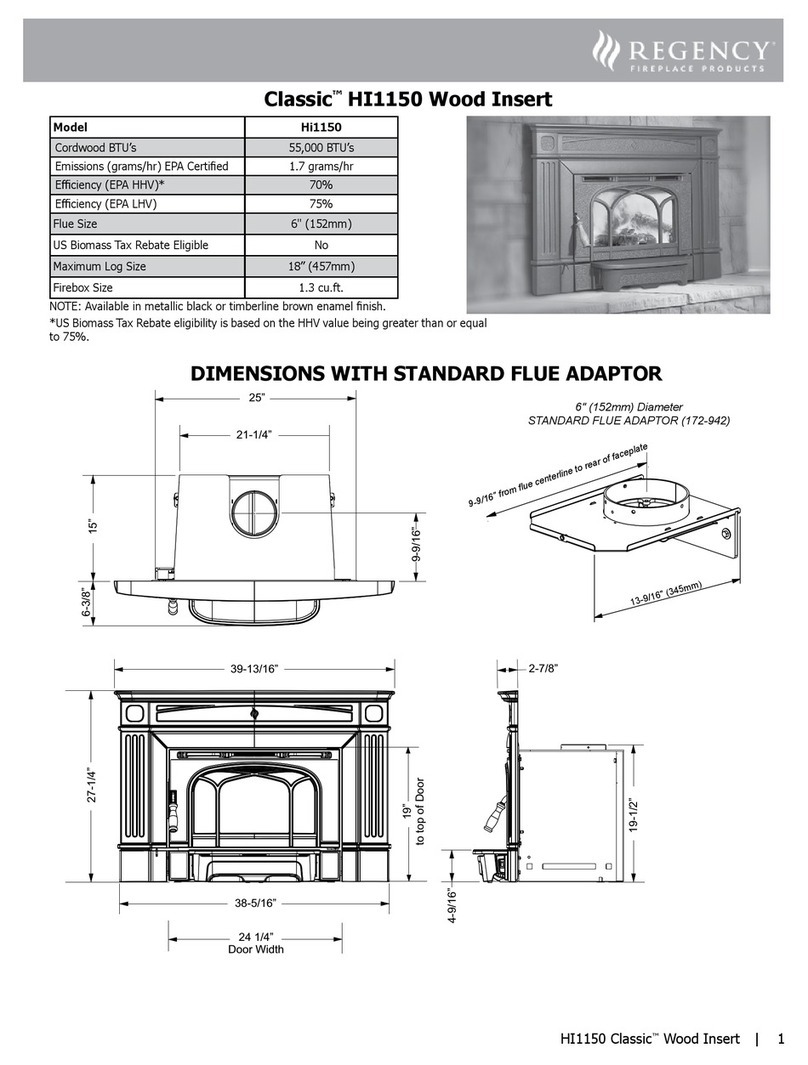
Regency
Regency Classic HI1150 Installation

Travis Industries
Travis Industries Avalon 1190 operating instructions

